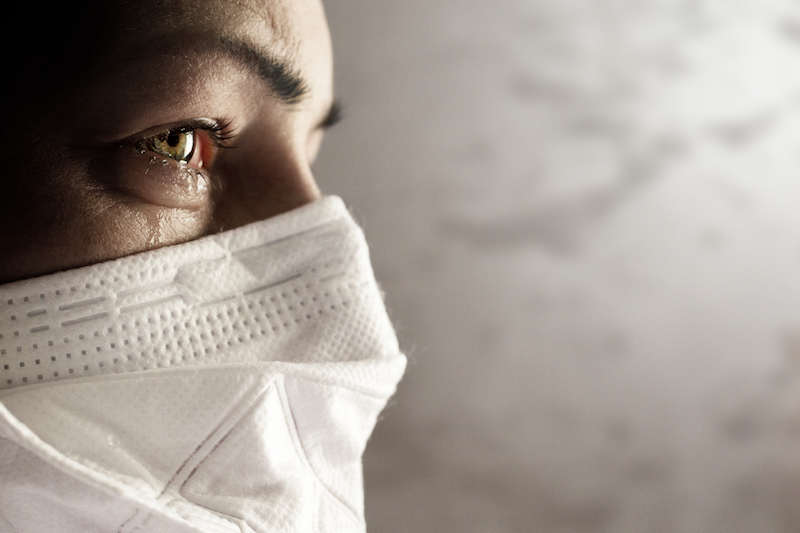New York, NY – It’s 10 a.m. and Nurse T. has rushed into Mr. M’s room because a monitor is showing his oxygen levels have fallen dramatically.

She sends a pliant plastic suction catheter down Mr. M’s endotracheal (breathing) tube in an effort to suck out the thick, bloody secretions that have choked the airways of his lung. The secretions have filled the tiny air sacs that expand and contract with inspiration and expiration. But now, the thick, tenacious secretions have also clogged the tube — Nurse T. cannot suction out any secretions; the ventilator cannot deliver the oxygen the patient needs to survive, even when the machine is set at 100% O2.
Mr. M. is a 61-year-old African-American male with long dreadlocks, tattoos on his arms and an arterial-venous fistula where he used to receive kidney dialysis. A kidney transplant patient and diabetic, he is profoundly immune-compromised and unable to fight off the Covid-19 virus. Mr. M’s wife and three children have not visited him since he was admitted to the medical ward, now essentially a Covid-19 unit.
Two days ago, Mr. M. transferred to the ICU with severe difficulty breathing, low oxygen levels in the blood and falling blood pressure. He was intubated and sedated. The ventilation system forms a closed seal, so when the nurse snakes the suction catheter down the endo tube, she can suck out the secretions without releasing droplets into the air. The staff makes every effort to minimize dispersion of droplets, knowing they will drift out of the room when the door is opened, and that the nurse herself will leave the room dusted with virus if the seal is broken.
During the night the pharmacy ran out of Fentanyl, the primary opiate infusion they use to sedate the patient. Morphine is also gone, as are the primary anesthetic Propofol and the sedative midazolam. Nurse T. has struggled to keep her patient calm with intermittent injections of Ativan, but this drug, too, is in desperately short supply, and she hasn’t enough to keep the patient sedated.
Half-wake and mad with the feeling of suffocation that his drowning lungs produce, the patient starts to breath rapidly. His respiratory rate is in the 50’s – so rapid and shallow that he never takes in any fresh air. This makes the feeling of drowning even worse.
M.’s heart rate climbs to 150…160..170..180! At this rate the heart hasn’t time to fill during the relaxation phase of the cardiac cycle. Its output drops to a miniscule volume, dropping his blood pressure down…down… down.
Nurse T. disconnects the tubing from the endo tube and attaches the Ambu bag. She vigorously squeezes the bag while the ventilator alarm sounds, but still she cannot force oxygen into the patient’s lung, the distal (end) portion of the tube is completely blocked. She yells for the crash cart, explaining she cannot suction the patient. The critical care team rushes into the cramped room.
The Critical Care Fellow (who had been home sick with COVID-19 and is now, hopefully, immune) suggests removing the tube and replacing it with a larger #8 bore. Anesthesia is squeamish, they usually don’t like fat tubes, fat tubes can erode the trachea, which leads to devastating complications. But the ICU Attending.
Hurriedly, Nurse T. pulls the new tube from the red crash carts, rips open the packet with the black stripes confirming it has been sterilized and hands it to the Fellow. The Fellow visualizes the airway and deftly slides the tube into place. Nurse T. inflates the little pilot balloon that will seal it in place and quickly secures the tube with tape.
They work on the patient, giving oxygen, compressing the chest manually, shooting drugs into the bloodstream to try and elevate the blood pressure, but she knows the effort is useless. Mr. M. had grown cold, his transplanted kidney had ceased to function, and his other organs were failing as well.
The Attending calls off the code. The team members rip off their isolation gowns and exit the room, leaving Nurse T. to clean the patient and prepare him for transfer to the makeshift morgue out in the parking lot.
As she wipes the secretions off Mr. M.’s face and chest, she wishes the Attending Physician could write in the death certificate under cause of death: hospital poverty due to refusal of the gov’t to provide adequate resources and staff for impoverished patients of color.
She finally leaves the room and calls for the morgue attendant. The attendant asks if she has heard the news? What news? Mr. Prince, an African American nurse tech in the ER, has died in one of the other ICU’s. His wife is in a coma in the next bed.
Nurse T. hangs up the phone. She is too forlorn to cry.
This report is based on conversations with Nurse T., and her colleagues who work in an ICU in a New York hospital that serves a a largely impoverished black and Hispanic community.
Timothy Sheard, a retired RN, worked in hospitals for over 40 years. He is an author of medical mystery novels and founder of Hard Ball Press, a social justice imprint.



